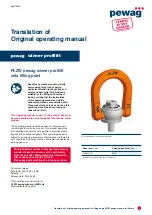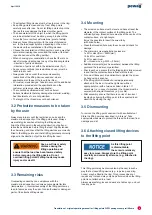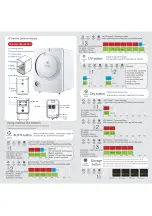
April 2019
2
Translation of original operating manual for lifting points PLZW pewag winner profilift zeta
Table of contents
1. Safety instructions
2. Designated use
2.1 Restrictions on use
2.2 Foreseeable misuse
2.3 Labelling and identification
3. Assembly instructions
3.1 General information
3.2 Protective measures to be taken by the user
3.3 Remaining risks
3.4 Mounting
3.5 Dismounting
3.6 Attaching closed lifting devices to the lifting point
4. Inspection, maintenance and repair
4.1 Inspection
4.2 Discard criteria
4.3 Procedure in case of accidents or faults
4.4 Maintenance
4.5 Repairs
5. Storage
6. Removal from service
Tables
• This product may only be operated by properly trained
persons who must comply with all relevant standards and
country-specific regulations.
• Users of this product must be in a good physical condition.
Users of this product must not be under the influence of
drugs, alcohol or medication.
• You must ensure that a plan that specifies emergency
measures is available and that it covers all emergencies
that may occur during use.
• The product may not been modified in any way.
• All repair and maintenance activities must be performed in
accordance with the instructions given by pewag.
• Check for visible damage (deformations, cracks, damaged
threads) prior to each use and ensure that the product is
functioning correctly – lifting points have to be rotatable
(alignable with the load direction).
• The lifting point may only be loaded in the direction
specified (fig. 1 in point 2 of this manual), at the maximum
load capacity according to table 1 and in accordance with
the conditions of use specified in point 2 this manual.
• This product may not be used for the lifting or securing of
persons.
2. Designated use
Purpose:
The pewag PLZW is a lifting point that is screwed
onto loads so that lifting chain components (hooks,
shackles...) may be attached to enable the load to be lifted.
This lifting point may also be disassembled, which makes
it possible to attach closed lifting devices (e.g. eyes sling
hooks, rope loops) to the lifting point.
The turning of loads is admissible; however, continuous
rotation under load is not permitted.
Target groups:
This product may only be used and serviced
by properly trained personnel, provided that the instructions
of this operating manual and all relevant country-specific
regulations are complied with. Repairs, regular inspections
and the exchange of parts may only be performed by
competent personnel.
Also see point 4 of this operating manual.
Load:
The lifting point may only be loaded in the direction
specified (fig. 1), at the maximum load capacity according to
table 1 and in accordance with the conditions use specified in
this manual.
Fig. 1: Permitted directions of load that occur during correct use.
Fig. 2: Non-permitted usage
Operating temperature:
The long-term permitted operating
range is -20 °C to +200 °C. In case of usage outside this
temperature range, the reduction factors outlined in table 2
must be taken into account.
Shock loading:
Slight shocks, such as the kind that is
caused by acceleration during lifting and lowering of the load,
may be disregarded. Stronger shocks are not permitted.
1.
SAFETY
INSTRUCTIONS
An improperly mounted
or damaged lifting point
or improper use may
cause accidents that lead to severe injuries and/
or death! Damaged lifting points (see maintenance
instructions) may fail even during normal
conditions of use. Such lifting points may not be
used.


























